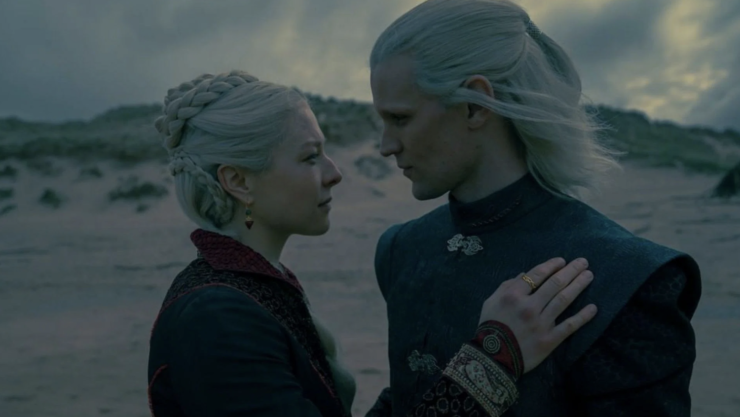The antepenultimate episode of this first season of House of the Dragon featured our last major time jump with recast actors, a miniature succession crisis with a gruesome outcome, a last supper for the Targaryen-Hightower-Velaryon clan that almost ends happily, and the botched communication of a deathbed prophecy. We’ll take a look at some of the relevant lore from Fire & Blood as well as other the wider world of Martin’s source material as we take a deeper dive into the events of the episode.
The Title
Episode 8 is entitled “Lord of the Tides,” an obvious reference to its focus on the gravely wounded Corlys Velaryon (Steve Toussaint) and the question of who might succeed him. The phrase is, as explained in episode 7 by Lord Corlys himself, a style granted to the current head of House Velaryon (who also traditionally takes on the titles “Master of Driftmark,” and “Lord Admiral”). The Velaryon seat on the isle of Driftmark is an ideal position for the Westerosi navy as it sits across the mouth of Blackwater Bay, forcing ships from the Narrow Sea to pass through a strait known as “the Gullet” if they want to reach King’s Landing. Driftmark stands between the capital of the Seven Kingdoms and attack from the Sea, or it might keep embattled royals from escaping to the Free Cities should the Lord of the Tides turn on the Throne…
In Fire & Blood, Vaemond Velaryon (Wil Johnson) is Corlys’ nephew, not his younger brother. It feels like this minor change is mostly there to eliminate extraneous questions about the extended Velaryon family (e.g. what happened to Corlys’ brother/Vaemond’s father?) but it also has the effect of sharpening the family drama. Vaemond is portrayed in the book as a somewhat disconnected usurper, showing up at an opportune moment to seize power from his incapacitated uncle. Having kept Vaemond in the narrative as far back as episode 3 of the series, the showrunners have established him as a cornerstone of House Velaryon.
The show also (astonishingly) treats the proceedings surrounding the competing claims with a touch more civility than we see in Fire & Blood. In Martin’s original version, Rhaenyra, upon hearing that Vaemond means to claim the Driftwood Throne, sends Daemon to kidnap him, whereupon she has him decapitated and fed to her dragon, Syrax. By comparison, the airing of claims in the Red Keep has some modicum of decorum and even Vaemond’s semi-decapitation is at least sanctioned by Viserys’ previous decree that it is treasonous to name Jacaerys (Harry Collett) and Lucerys Velaryon (Elliot Grihault) bastards.
The Iron Throne Rejects Its King
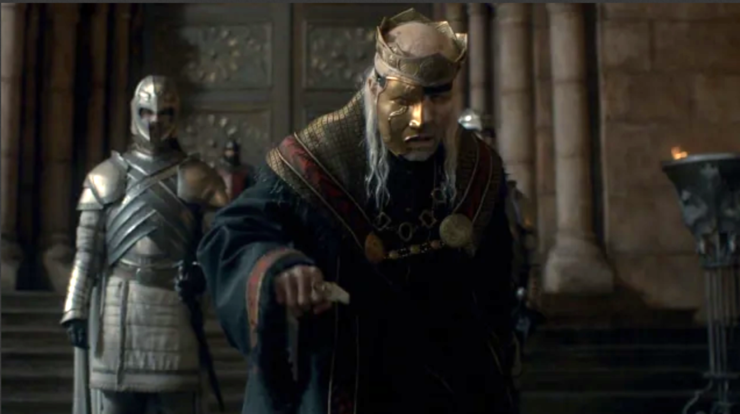
Viserys (Paddy Considine) has been ill since the first episode of the series and with his death at the end of this episode, we should look into the nature of that illness. The show’s official podcast has confirmed that Viserys has leprosy, which tracks with the amputation-necessitating infections in his extremities and his debilitating muscle weakness. This is a change from the book, where Viserys is described as being in somewhat better health but suffers from gout, respiratory issues, and back and joint pain.
Both the show and book, however, link some of Viserys’ injuries to the Iron Throne itself, which is part of a long tradition of auguring the fitness of a ruler based on their ability to remain in good health while literally seated on the throne. In order to understand this particular form of the The King’s Two Bodies, one needs to remember that the Iron Throne of Martin’s books is a much larger, more dangerous, and more sinister creation than the version we see on screen.
Martin has pointed to Marc Simonetti’s iconic illustration of the Iron Throne as the one which most resembles his personal vision of the Seven Kingdom’s most dangerous seat. It’s something one needs to climb in order to sit upon it, and far from the show’s neatly symmetrical design, it is a jagged, serrated mass of jutting blades, full of unseen dangers. The throne needs to be carefully navigated in order to sit properly and those who fail to do so incur injuries from its errant blades.
Viserys cutting his finger on the throne in the first episode is one of many injuries which eventually fester and overwhelm him. This will become a part of his story and an outward sign of the ways in which he squandered his rule by naming his daughter as heir and subsequently refused to address the clear tensions and crises in his court, instead blindly attempting to impose an illusion of unity between the irreconcilable branches of his family. His great-great-uncle, Maegor Targaryen, known as Maegor the Cruel, would end his reign impaled on the blades of the throne in an act that, though almost certainly a murder by one his many detractors or wives, is characterized by later generations as being the will of the Iron Throne itself. In 150 years or so, his descendant, Aerys II—the Mad King—will be known as “King Scab” by members of his Kingsguard due to the number of cuts on his hands, arms, and legs, necessitating that he be constantly bandaged and gloved.
Viserys is far from the worst king to sit the Iron Throne, but he is one of the unlucky ones to be marked by it: rejected by the office itself.
The Faith of the Hightowers
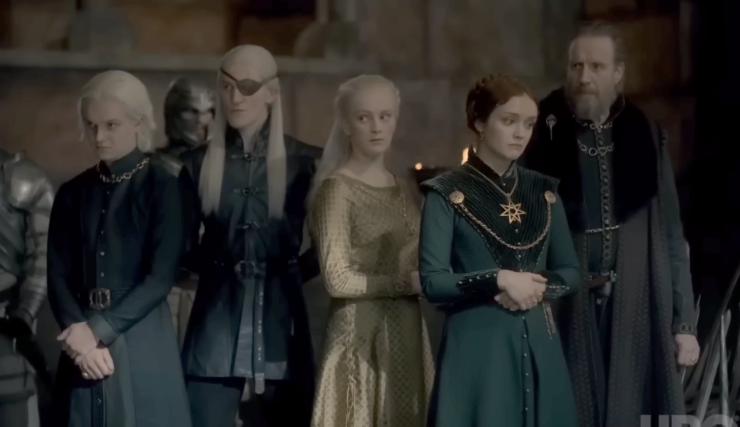
As Alicent (Olivia Cooke) and Otto Hightower (Rhys Ifans) assert more control over the Red Keep, the decadence of the Targaryen dynasty has been stripped away and replaced with more austere and pious decor. Similarly, Alicent herself affects a conservative, braided hairstyle and jewelry that reflects the seven-pointed star that symbolizes Westeros’ most popular faith.
There is a long history of the relationship between the Hightowers and the Faith of the Seven. As I wrote in my explainer for Episode 5, Oldtown, the seat of House Hightower, is the center of the Faith of the Seven at this time in Westerosi History. The Great Sept of Baelor serves as the seat of the High Septon during the era of the original Game of Thrones series (at least until, in the show, Cersei Lannister blows it up with wildfire), but that won’t be built for another 40 or 50 years after the end of House of the Dragon. At this time, the High Septon and all of the apparatus of the Faith of the Seven reside in and around the Starry Sept of Oldtown.
Built of black marble and guarded by Oldtown’s high walls and formidable navy, the Starry Sept is indebted to House Hightower, whose coffers enrich its influence and whose second sons often become important members of its clergy. When Aegon the Conqueror’s armies and dragons threatened to burn Oldtown to the ground, it may have been the High Septon who prayed on that matter and had a vision of Aegon’s divine right to rule Westeros, but it was Lord Manfred Hightower who opened the gate to let him into the city. Aegon’s coronation was held in the Starry Sept a couple years later.
Buy the Book
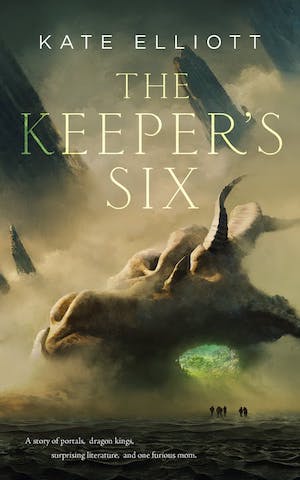

The Keeper’s Six
One can look to the example of the Faith Militant uprising that ended about 60 years before the events of House of the Dragon in order to understand the questionable and manipulative ties between the Faith of the Seven and House Hightower. The Faith Militant uprising is a complicated conflict in Westerosi history but it boils down to various High Septons taking issue both with Targaryen incest and Targaryen polygamy (this eventually results in the Doctrine of Exceptionalism under Viserys’ grandfather, King Jaehaerys I, which I discussed in my Episode 2 Explainer). With the Targaryens declared abominations by the High Septon, members of the military arm of the Faith of the Seven, including the ordained Warrior’s Sons and the ad hoc Poor Fellows, waylaid Targaryen loyalists on the road and eventually encamped outside Oldtown’s gates. There are two inflection points in the conflict, however, that point to Hightower involvement.
- The first occurred when Visenya Targaryen offered to marry her son Maegor to Ceryse Hightower, the daughter of Lord Manfred. Thus, the political appeasement of the Hightower family led to a temporary lull in the Faith’s furor over Targaryen incest and polygamy.
- The second occurred after Maegor declared he would marry Alys Harroway, thus continuing the tradition of Targaryen polygamy. This further outraged the Faith Militant and the High Septon and brought things to a violent head. Maegor marched on Oldtown to destroy the encampment of the Faith Militant and put an end to the Faith of the Seven. Manfred’s eldest son, Martyn Hightower, was now Lord of Oldtown and his second son, Morgan was the commander of the Faith Militant in Oldtown. The city surrendered after the sudden death of the High Septon. The Warrior’s Sons were all put on trial and were offered the choice of execution or taking the Black—all except Morgan Hightower who many believed was spared for having secretly murdered the High Septon while Lord Martyn lobbied the council of the Most Devout to install a replacement more sympathetic to Targaryen custom.
Thus, while Alicent’s faith appears to be genuine, Rhaenyra’s assertion that it is a “cloak of righteousness” references the ways in which House Hightower has often mixed religion and politics, using the High Septon to their own expedient ends and exerting a subtle influence over the Church of Westeros and its doctrine.
We see a miniature version of this battle between the holy and venal in Alicent during this episode when Dyana (Maddie Evans), a servant, reports that she was sexually assaulted by Prince Aegon. The Queen takes the opportunity to both validate the girl’s experience and fill her mind with doubts about public reaction to her story. She ends this conversation by paying her off after forcing her to drink an abortifacient tea. One can see, both in this scene and in the subsequent one where she confronts Aegon with his crimes and declares that he is no son of hers, that Alicent is rightly horrified by her son’s crimes and wants to provide comfort to his victim. But she cannot help but spin the incident to help her family save face and pressures Dyana to agree to the faux-Medieval equivalent of an NDA.
Odds and Ends
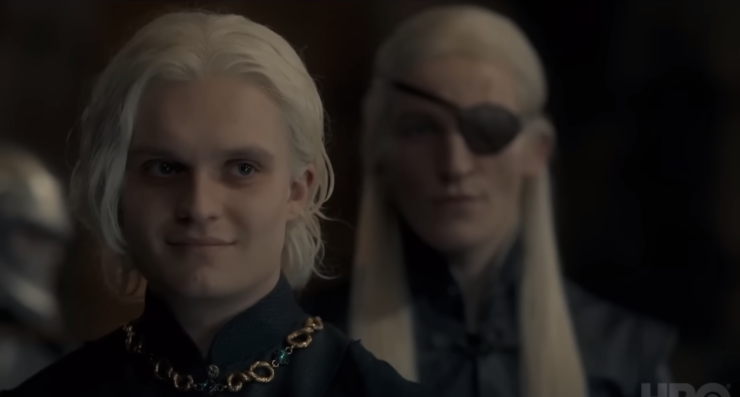
Ser Arryk and Ser Erryk
At one point, Alicent is guarded by Ser Erryk Cargyll (Elliot Tittensor), whom she mistakes for his twin brother, Arryk (played by Tittensor’s real life twin, Luke). These characters are forerunners in Martin’s texts to a pair of twin guards to Lady Olenna Tyrell during the era of the original Game of Thrones series. That Erryk and Arryk are both seven feet tall and nearly indistinguishable from one another, leading the Queen of Thorns (played, in the original series, by the inimitable Dame Diana Rigg) to simply refer to them as “Left” and “Right.” Seeing as those characters were cut from the original show and the joke was left unuttered, I wouldn’t be surprised to see it turn up in this series with the Kingsguard twins that Olenna’s guards were likely named for.
The Blacks and the Greens
We get a semblance of the banquet with the Blacks and Greens in this episode, albeit reconfigured into the intimate family dinner where Viserys takes a last look at his family. The original, which I discussed in more detail in last week’s explainer, was a celebration of Viserys and Alicent’s fifth wedding anniversary, open to much of the court. By altering it into a private dinner, the showrunners pull a masterful little reversal of all the feelings that book readers think ought to be associated with this key scene. In Fire & Blood, it represents the first seeds of the enmity between Rhaenyra (Emma D’Arcy) and Alicent that will later poison the realm. In House of the Dragon, it is a final moment of possibility when the two childhood friends might set aside their differences and heal the wounds that split House Targaryen.
It’s a surprisingly moving switch, letting the Princess and the Queen, in black and green, have a moment of real connection and empathy on behalf of a dying man who only wishes to see his family love each other as much as he loves them. Even as the scene goes on to prove that the poisonous enmity with which they have infected their children cannot be pacified, the two remain, for a moment, hopeful that they can reconnect. The longing on their faces is agonizingly bittersweet.
***
This episode continues to showcase the fact that House of the Dragon is at its best when it is playing out a quiet family drama whose stakes just happen to have dire, kingdom-wide repercussions. I am not yet sure how I feel about Viserys’ Citizen Kane-esque deathbed proclamation, which seems destined to give Alicent another reason to push for the succession of her despicable eldest child. But I am sure that I will miss Paddy Considine’s presence on the show. He imbued Viserys with a heartbreaking, vulnerable pathos that made his doomed crusade to reunite his family something far more emotional and resonant than a simple retread of Martin’s penchant for starting his stories with an incompetent, oblivious king sowing the seeds of future strife. What did you think? As we close in on the endgame of the first season, are you enjoying the direction the show has pulled the narrative? Are you, like me, coming to love Olivia Cooke and Emma D’Arcy just as much as their predecessors? What are you hoping to see in the last two episodes? Let me know in the comments below!
Tyler Dean is a professor of Victorian Gothic Literature. He holds a doctorate from the University of California Irvine and teaches at a handful of Southern California colleges. He is the author of “Distended Youth: Arrested Development in the Victorian Novel” and his article “Exhuming M. Paul: Carmen Maria Machado and Creating Space for Pedagogical Discomfort” appears in the most recent issue of Victorian Studies. He is one half of the Lincoln & Welles podcast available on itunes or through your favorite podcatcher. His fantastical bestiary can be found on Facebook at @presumptivebestiary.










